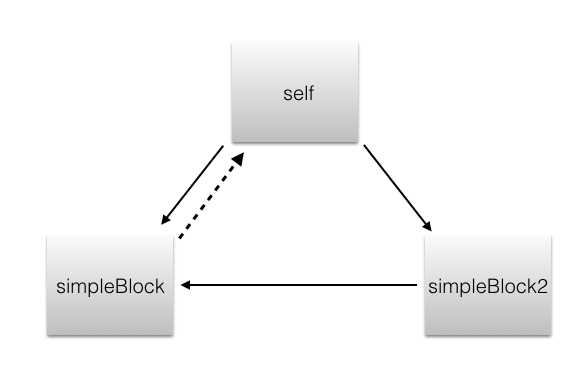标签:
^{ NSLog(@"This is a block"); }
void (^simpleBlock)(void);
类似int i;
simpleBlock = ^{ NSLog(@"This is a block"); }
类似i = 2;
void (^simpleBlock)(void) = ^{ NSLog(@"This is a block"); }
类似int i = 2;
simpleBlock();
^(double firstValue, double secondValue) { return firstValue * secondValue; }
or
^double (double firstValue, double secondValue) { return firstValue * secondValue; }
double (^multiplyTwoValues)(double, double);
multiplyTwoValues = ^(double firstValue, double secondValue) { return firstValue * secondValue; };
double (^multiplyTwoValues)(double, double) = ^(double firstValue, double secondValue) { return firstValue * secondValue; };
double result = multiplyTwoValues(2,3);
int anInteger = 42; void (^testBlock)(void) = ^{ //此时只是Block定义,并没有执行里面的函数 NSLog(@"Integer is: %i", anInteger); }; anInteger = 84; testBlock(); //Block调用 输出42
Value is captured when the block is defined.
Block定义的时候,将值复制一份给自己,所以该值已经不受外界影响。
__block int anInteger = 42; void (^testBlock)(void) = ^{ //此时只是Block定义,并没有执行里面的函数 NSLog(@"Integer is: %i", anInteger); }; anInteger = 84; testBlock(); //Block调用 输出84
Because anInteger is declared as a __block variable, its storage is shared with the block declaration.
此时Block里面的值与外面的值共享同一份内存
It’s important to take care when capturing self because it’s easy to create a strong reference cycle when capturing self.
因为变量默认是__strong修饰(详见这里),所以要时刻注意在block里面对self的引用(只要出现了self关键字就算引用了,因为block会自动capture)
假如self里面定义了一个block,那么self有一个指向block的strong指针(比如该block是self的一个strong成员变量);假如block里面使用了self,则block也默认拷贝了一个指向self的strong指针,此时形成strong reference cycle.
解决方法:在Block前面创建一个__weak类型的指向self的指针,并在block里面使用该指针。
例子
__weak typeof(self) weakSelf = self; //学习下这种写法哦 typeof(self) self.simpleBlock = ^{ [weakSelf f]; }; ... self.simpleBlock();
但是,假如Block里面又有一个Block,怎么办?最好是强引用weakSelf,此时strongSelf强引用的是weakSelf而不是self,所以不会形成strong reference cycle
__weak typeof(self) weakSelf = self; //学习下这种写法哦 typeof(self) self.simpleBlock = ^{ [weakSelf f]; __strong typeof(weakSelf) strongSelf = weakSelf; self.simpleBlock2 = ^{ [strongSelf f]; }; self.simpleBlock2(); }; ... self.simpleBlock();
图解

A Block Should Always Be the Last Argument to a Method.
It’s best practice to use only one block argument to a method.
typedef int (^Sum)(int, int); Sum mySum = ^(int a, int b){ return a+b; }
or
typedef void (^XYZSimpleBlock)(void); @property (copy) XYZSimpleBlock blockProperty;
@property (nonatomic, copy) Sum mySum; @property (nonatomic, copy) void (^blockProperty)(void);
非ARC下就必须写copy,because a block needs to be copied to keep track of its captured state outside of the original scope
在ARC下写不写copy都无所谓,so it‘s a best practice to set copy property for block whether it‘s ARC or not.
《Programming with Objective-C》第八章 Working with Blocks
标签:
原文地址:http://www.cnblogs.com/chenyg32/p/4912896.html